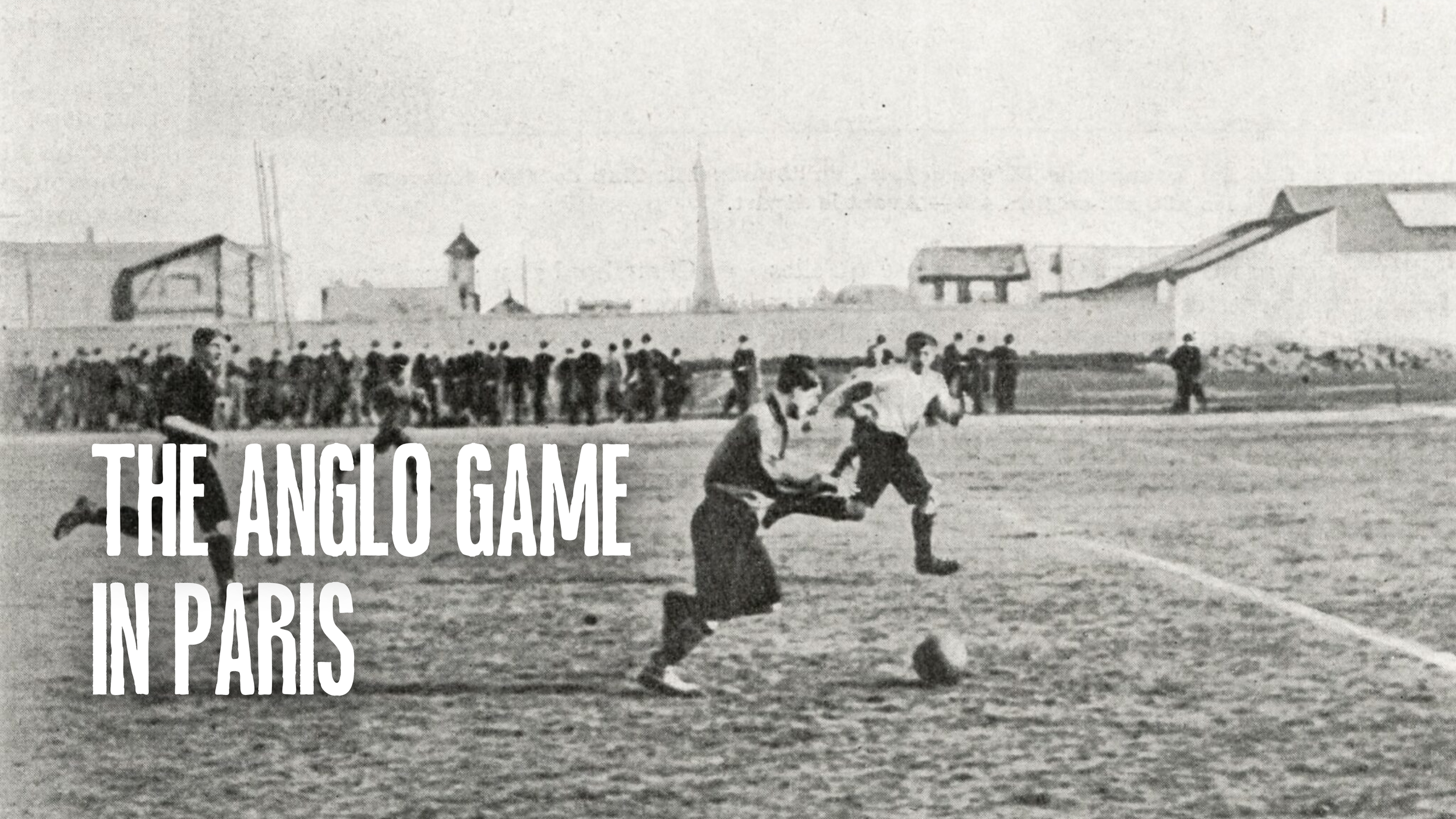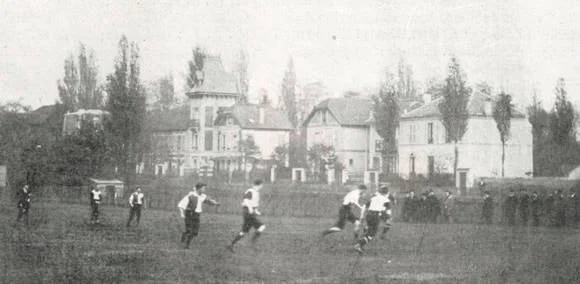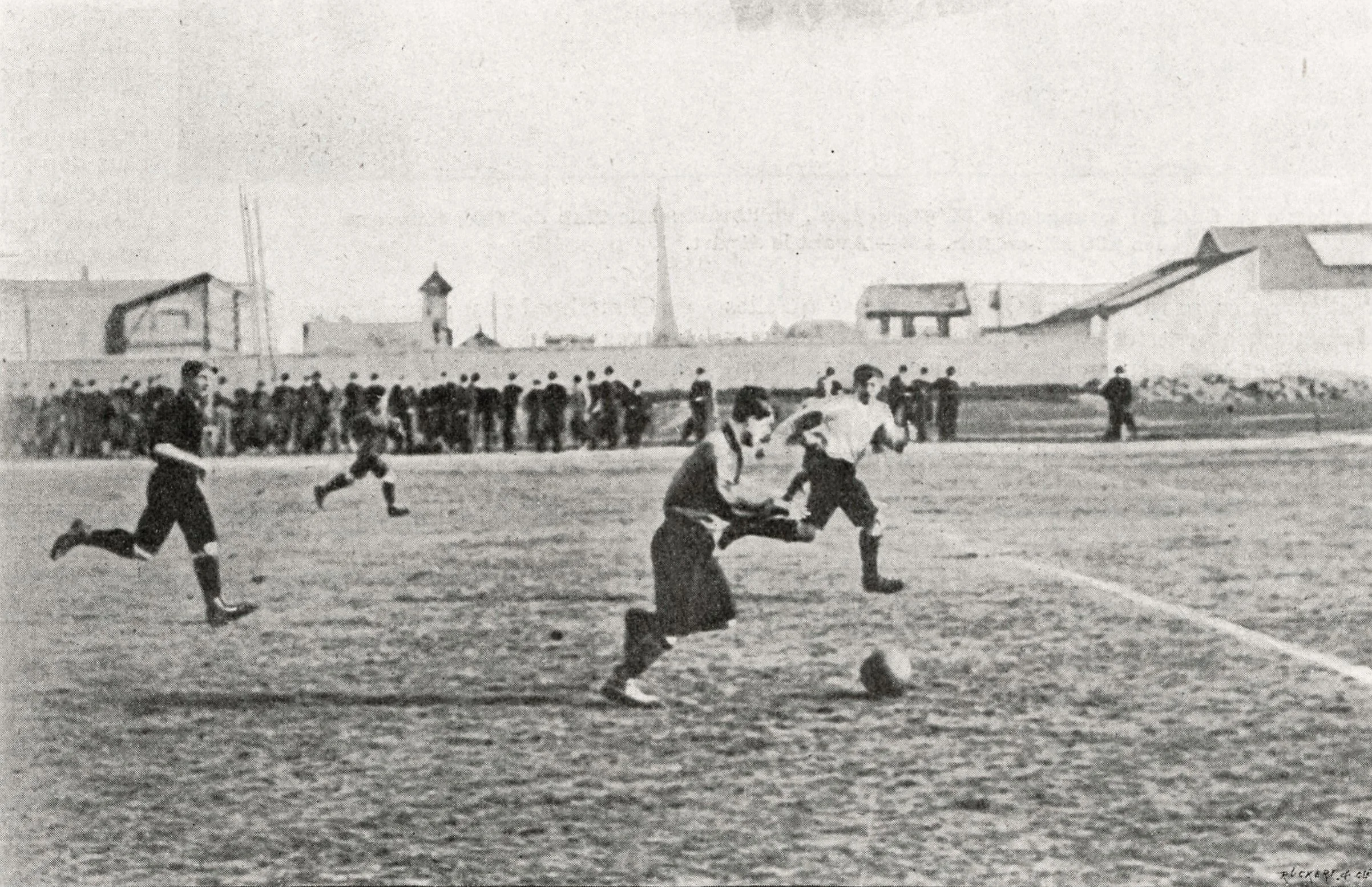Words: Jonee // @Jonee13
In the latter decades of the 19th century, England was well on its way to inventing and exporting modern sport. Association football, codified in the 1860s, was growing fast in the British Isles; industrialisation, urbanisation, the expansion of rail and steam travel, and the rise of leisure time among the middle classes meant that not only did towns demand recreation, but expatriate communities abroad carried their cultural practices with them. It is in this crucible of British influence, expatriate networks, and cultural exchange that football made its first foothold in France.
French interest in English sports was not a late or accidental phenomenon. The port town of Le Havre, among the earliest centres of trade with England and home to many British residents, saw informal matches and clubs from the 1870s. British sailors in port, dockworkers, sometimes those associated with the shipping trade, played informal games of “kicking the ball” among themselves, or in mixed groups. Thus there was a slow accretion of familiarity with the rules—at first loosely, often confused with rugby or other “football” codes, but gradually solidifying into association rules. This influence was reinforced by young French men who travelled to England for study or work (engineering, commerce), and who brought back not just admiration for English practice but sometimes sets of rules, balls, goalposts, and a zealous desire to try matches in France.
Moreover, the British model of sports clubs—social, amateur, and organised—proved appealing. Clubs combining athletic, social, and often expatriate membership already existed in other sports such as rowing, tennis, and cricket. The sense of order, rules, sportsmanship, of playing for no reward but for prestige or honour, resonated with some French elites, especially in Paris, who saw sport as a means of physical education, of cultivating character, and of linking France to modern European cultural currents.
So it was that in Paris in the early 1890s, among British expatriates, Americans, and French who had been exposed to British life, conversations began: could we have a club to play “the English game” properly? The first known inter‑club games in Paris took place informally; then came the more organised efforts. One key moment was in the late autumn of 1891, when Jack Wood, an Englishman who had played amateur football at home, arrived in Paris, found few to play with under association rules, and in concert with others met at the Café Français on Rue Pasquier.
There, after a narrow vote, they chose association football rather than rugby rules. Thus was founded The White Rovers, largely composed of Britons and Americans. Its early roster included people like William Sleator, who is credited with importing one of France’s first sets of goalposts, Emile Ernest Cox, Walter Hewson, Edward Barclay (London‐born), Claude Rivaz, and others. Many had been educated or lived in England or Belgium, and several had played in early British‑style clubs. The club’s patron was Henry Blount, son of the British Consul, which helped in securing both social legitimacy and a ground in Bécon‑les‑Bruyères (Courbevoie), near the railway station.
Parallel to The White Rovers, Standard Athletic Club emerged earlier, in March 1890, also with strong British involvement. Founded by businessmen and expatriates gathering socially in Paris, Standard AC was one of the first organised clubs in which association football gained coherence beyond casual “kick‑abouts”. These clubs shared not merely enthusiasm but equipment, practices, norms: imported balls, goalposts, perhaps instruction, match arrangements, uniforms, and so on. The early clubs in Paris played matches against each other: Standard AC, Club Français (which soon had French players), International AC, and The White Rovers. These inter‑club matches, in 1892‑93, though informal by later standards, were crucial laboratories: for rules (how long is a match, how many players, what to do with ties), for social conventions, for spectatorship and for creating rivalry.
The beginnings of football in Paris owe much to the British community living there—engineers, tradesmen, people educated in Britain, and those who had spent time there. Their familiarity with football and desire for recreation led naturally to organising club games. It was in that milieu, in 1890 and 1891, that Standard Athletic Club and The White Rovers respectively emerged as among the very first clubs in France to take up association football in an organised way.
Standard Athletic Squad Photo, 1901.
Photo Credit: Sports Gazette
Another key institution was the Union des Sociétés Françaises de Sports Athlétiques (USFSA), founded in 1887 (or formally in 1889) as an umbrella for all sorts of athletic associations. The USFSA’s willingness to embrace British‑style football (association rules) was essential. Without a regulatory body to sanction, organise, and adjudicate contests, early matches would remain marginal. British clubs and British individuals played roles in USFSA from early on; their participation and demonstration of stable club form (grounds, members, adherence to rules, even regular fixtures) pushed the USFSA to incorporate football into its remit, to permit championships, to codify rules in ways coherent with British norms.
The USFSA was somewhat conservative in other regards, but could not ignore the momentum. This British‑imported sporting culture also came through newspapers, expatriate social clubs and schools, sometimes via travel and trade links. French newspapers of athletics and sporting journals reported on matches, publicised fixtures, and occasionally imported trophies or donated cups—sometimes by English or Anglo readers or businessmen. The standard of the game, the idea of gentlemanly conduct and respecting opponents came in part from Britain’s long ‘public school’ tradition, and clubs like White Rovers and Standard AC practised (and sometimes adapted) those norms.
By the early 1890s, Paris had a small but growing cluster of clubs which were British or British‑influenced, playing under association rules, with enough structure (grounds, members, fixtures) that more formal competition became possible. It was a short step from these informal matches to the first USFSA championship in 1894, in which Standard AC and White Rovers played central roles.
That championship was a watershed: it marked the point where football in France began to be something more than an imported foreign curiosity. It began to have institutional structure, permanent clubs, rivalries, rules, vestments (uniforms), trophies, and records. It is this moment that anchors the stories of Standard Athletic Club and The White Rovers. Their subsequent rise, struggle, decline, and legacy can best be understood as unfolding from this British seed, planted in French soil.
White Rovers play a match in November, 1898.
PhotoCredit: Wikimedia Commons
After The White Rovers were formally established in late 1891, they wasted little time in seeking out competition. Their first challenge match came in March 1892 when they played against International Athletic Club (“International AC”), affectionately nicknamed “Inter‑Nos”. White Rovers won decisively, 10-1. It was the first known inter‑club match in France of significance, one of the earliest proofs that association football could be played seriously, with rules, with scorekeeping, and with competition.
That match exposed both potential and weakness: while White Rovers dominated the match, standards of equipment, ground condition and opponent organization varied. But over the 1892‑93 season the three main clubs in Paris—White Rovers, Standard AC, and Club Français—met repeatedly. White Rovers beat Standard AC multiple times (5‑1 in December 1892 and again in January and March 1893).
White Rovers played in white shirts with a large blue Maltese cross; Standard AC adopted red and black stripes later. Grounds had to be secured—White Rovers got Bécon‑les‑Bruyères via Henry Blount’s patronage. These were not trivial matters: in a rapidly urbanizing Paris, land was scarce and expensive; securing stable fields meant negotiating with landowners, sometimes facing pressure as city expansion ground up undeveloped land.
The White Rovers’ early governance shows the British imprint. Jack Wood and his brother Tom presided over the club. William Sleator was treasurer and is credited with helping import early goalposts. Edward Barclay, Walter Hewson, Claude Rivaz, Emile Ernest Cox and others played took on administrative duties. Many had been educated in Britain, had British or American nationality, or had prior exposure to British sports culture. This affiliation gave them access to knowledge of rules, equipment and a network of suppliers. It also gave them prestige: for example, Henry Blount, being from a socially well‑connected British family, conferred patronage and legitimacy.
Standard AC too had British founders and players. Among them were members of the Wynn family who played in early finals and in representative matches, and William Attrill who captained the club in early championships. These individuals were not merely players but organizers: they recruited new members, arranged fixtures, negotiated with clubs and with the USFSA. Some French members joined as well; over time clubs became more mixed. But in the crucial early period, British members provided much of the infrastructure: norms of conduct, rule‑knowledge, and occasionally finances or equipment. Sometimes, they even arranged rail travel and expenses to and from matches.
These people also had to manage the transition to more formal competition: agreeing to replays (in finals), choosing or accepting governing rules, accepting match officials, setting up referee systems and producing schedules. In many cases, clubs like White Rovers and Standard AC were pushing the envelope in this regard. Their willingness to experiment, sometimes to forfeit matches (White Rovers famously not showing up for the 1897 play‑off), to protest or adjust, shaped the procedural precedents that later clubs would follow.
White Rovers squad photo, 1895.
Photo Credit: Wikimedia Commons
The USFSA’s first official championship in 1894 was both a product and a catalyst. With six clubs entering—Standard AC, White Rovers, International AC, Club Français, Cercle Athlétique de Neuilly, Cercle Pédestre d’Asnières—and with fixtures held on neutral grounds (e.g. Racing Club de France in Levallois), the championship introduced formal knock‑out structure, match scheduling, and even replays in case of ties. Standard AC and White Rovers found themselves at the centre: they met in the final, drew 2‑2, then Standard won the replay 2‑0.
Over the next years the format shifted between knockout and round robin league structures. 1896 saw a league style among Parisian clubs; in 1897, Standard and White Rovers finished tied on points, leading to a play‑off which Standard won by default. These evolving formats show how early competition demanded adaptation. The clubs involved had to accept new institutional rules. Standard AC often emerged victorious; White Rovers repeatedly came close but never quite matched their success6267.
Some matches stand out not just for result but for their symbolic weight. White Rovers’ 13‑0 thrashing of CA Neuilly in 1894 showed both their strength and the emerging gap between clubs. Later, the 1897 and 1898 play‑offs (or tied seasons) showed that competitive parity was increasing. Standard AC’s 1898 win over Club Français (3‑2) came after an intensely contested season. These contests served to raise standards: clubs had to better train, organise, recruit and manage their grounds.
From mid‑1890s, the pressure built for opening up competition beyond just Paris. Clubs in Le Havre, in Normandy, and in the provinces more generally, had been playing the. But for competitive fame, Paris clubs dominated because they had the infrastructure and numbers. In 1899, the USFSA expanded the championship so that provincial clubs could enter. That year saw Le Havre Athletic Club winning their first title when competition opened up.
This expansion marked a key turning point: the game in France was no longer exclusively a Parisian affair. The British pioneers in Paris had created not only clubs, not only matches, but visibility, records, norms and a governance structure via USFSA which could scale. They had shown that association football could be organised, fair, competitive, and interesting enough to attract not just spectators, but also press coverage.
The British influence in these institutional arenas was not always direct, but often present in shape or essence. People with British backgrounds were among early club administrators, British methods were adopted and adapted. The French adoption did not mean blind copying—it meant appropriation and adjustment—but the foundation was clearly British.
Although The White Rovers never won the national championship and dissolved around 1899, their life in those early years was densely meaningful. Their defeats and victories forced rivals to improve, while their organisational successes set examples. Their players and members mixed with French ones; over time, French players learned the game, and French‑only clubs like Club Français could compete and eventually win. The social space for football in Paris was transformed—from informal, ephemeral, amateur kickabouts into structured clubs, recognised championships, trophies, and newspapers covering fixtures.
Le Havre v Standard Athletic Club, 1901.
Photo Credit: Wikimedia Commons
Standard Athletic Club, by contrast, managed to sustain its competitive edge in early championship years, garnering multiple USFSA titles (1894, 1895, 1897, 1898, 1901) and being among the clubs with stability in administration and grounds. Its later decades saw its football section fade from national prominence as professionalism, larger local clubs, and broader popular support shifted competitive balance elsewhere. But Standard AC left behind a physical and symbolic legacy where they are remembered as pioneers of the organised game in France.
Today, clubs, historians and football federations in France trace their national lineage, in part, through these early pioneers. The structures that govern modern French football owe something to the template laid by those British‑born or British‑influenced clubs. The fact that Standard AC still exists, though not as a major professional side, means that memory is alive; the fact that The White Rovers are often mentioned in histories, in museum exhibits, in club histories, show that even clubs which disappear can cast a long shadow.
Standard Athletic Club and The White Rovers introduced association football as a serious organised sport in the Paris region. They shaped early club culture and inter‑club rivalry, enabled the transition from expatriate amateur games to competitions involving clubs with French players, provincial clubs and more structured leagues. Their importance in the historical landscape of football in France cannot be understated.
White Rovers, though short‑lived, were an essential counterpart to Standard AC. Their repeated challenges pushed Standard and other clubs to raise their competitive standards. Standard AC, with its repeated titles and sustained presence, both achieved glory in the early era and played a stabilising role. Though The White Rovers disappeared around 1899 and Standard AC ceased to be a national power fairly early in the 20th century, their legacy is far from dead.
Standard AC still exists today as an Anglo‑French sports and social club in Meudon, just outside Paris. Sports such as tennis, cricket, field hockey and more are part of its offerings. Although football is no longer its main competitive claim to fame, the history, colours, traditions, and facilities carry echoes of its past. The club remains, in a surprising way, a living link to the earliest days of French football.
There is also a broader symbolic legacy: the early trophies, photographs, and the early record books—some of which are preserved in the archives of the Fédération Française de Football (FFF) and other institutions—serve as reminders of where French football came from. The fact that Standard AC won the first ever French championship in 1894, and that the original trophy (donated by James Gordon Bennett Jr.) is still recognized in museum exhibitions, shows that these early events are not forgotten. These historic items are important touchpoints for football supporters seeking the heritage of the game in France.
White Rovers taken on the All Germany select (dark shirts) at Courbevoie in December 1898.
Photo Credit: Wikimedia Commons







